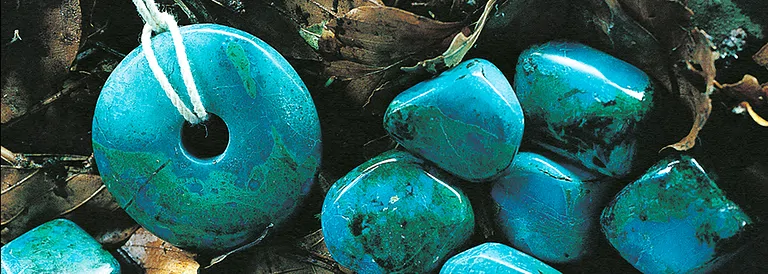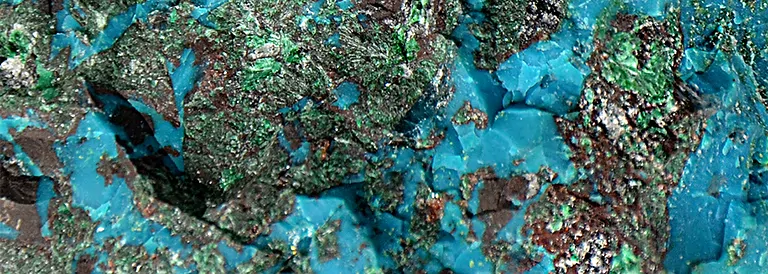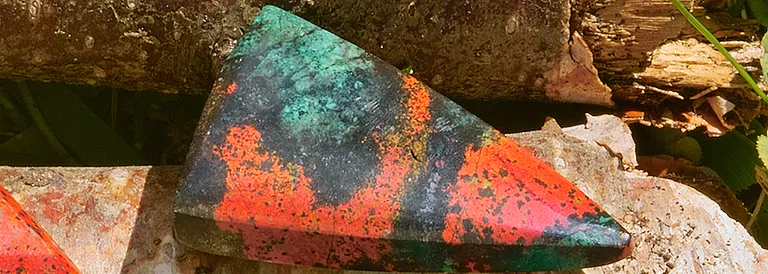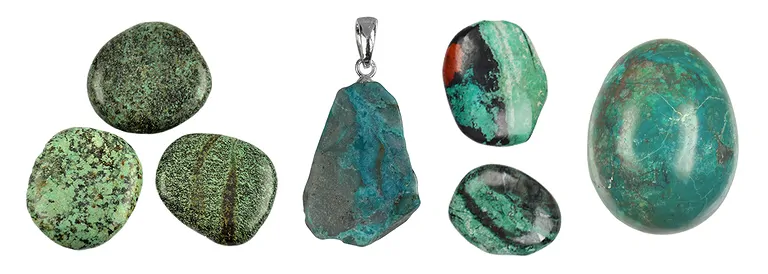
Chrysocolla - Meaning, effect and application
Chrysocolla can help in hectic times to keep a cool head and do the necessary things in a balanced way. The stone can help to orient in troubled periods of life or year and steadily pursue their own goals. The consequences of one's actions can be perceived more consciously with its help.
Mythologically, Chrysocolla was known mainly in Native American cultures and was considered a healing stone that strengthens resilience and helps harmonize upset emotions. Ancient granulations of Gold can be admired in the State Collections of Antiquities in Munich or in the Museum of Applied Arts in Cologne. Since the mineral is quite soft and fragile, Chrysocoll today is stabilized with resin on the surface for jewelry use, so that the stone can be shaped, cut and polished.
Chrysocolla bracelets, stringed beads, tumbled stones and more here in our wholesale web store
Origin of the name Chrysocolla
Chrysocolla translated means "gold glue" (Greek. chrysos = gold, kolla = glue). The origin of the name, however, can not be traced with certainty. Either the fact that untreated Chrysocolla sticks to the tongue because of its porous structure can be cited for it. Or the name comes from antiquity, when copper minerals were used as gold glue in granulation, i.e. as an aid in the goldsmith's art of the time for soldering as "glue" for gold beads. The latter is considered the most likely origin of the name. Before 1808, the term was probably used for several copper minerals, but then clearly assigned to only this one mineral by the geologist and mineralogist Brochant de Villiers (1772 - 1840). Synonyms are liparite, malchite silica, siliceous malachite, resanite, greener, copper hydrophan, green ore, dillenburgite, mountain green, traversoite, verdigris, atlaserz, chalcostactite, catangite, llanca, Spanish green, siliceous copper, and copper green.

Formation of Chrysocolla
Sites and varieties of Chrysocolla
Worldwide Chrysocolla could be proven at more than 2700 localities so far. The most important occurrences are Peru and USA (Arizona and Nevada). Zaire and Peru are also known by the intergrowths with Malachite and the countries Israel, Mexico and Peru by the Eilath stone, a mixture with Malachite and Turquoise, which can contain also some Azurite. Chrysocolla together with Azurite is called Copper Blue, with Kaolinite Pilarite, with Chalcedony Chrysocolla Chalcedony and finely disseminated in Chalcedony, Quartz or Opal Gem Silica. Chrysocolla druses consist of Chrysocolla agate with a crust of small quartz crystals.
Hardly available rarities of Chrysocolla are Sonora Sunrise, Chrysocolla diorite and Chrysocolla in Rhyolite. Chrysocoll with cuprite is also called "Sonora Sunrise". As copper oxide, Cuprite also occurs secondarily and paragenetically with Chrysocolla, and as an intergrowth it is called Sonora Sunrise. The stone got its name because of its locality, the Milpillas copper mine in the Sonora Desert (northern Mexico). The different colors from dark brown-red over black up to green-blue result from the mineralogical composition of the individual pieces. Each of the minerals on its own is not rare, but in this colorful amalgamation is found only in the small occurrence in Mexico.
The EPI Institute www.epigem.de found the more precise composition in its X-ray-tenographic methods:
+ green-blue areas: Intergrowth of the copper sulfate brochantite with the green copper silicate Chrysocolla
+ brown- to orange-red areas: Copper(I) oxide cuprite
+ black areas: Copper(II)oxide Tenorite
Chrysocoll diorite is also known in the trade as African Chrysocolla or because of its coloring also as African Turquoise. A closer examination of the EPI Institute revealed: the parent rock is a decomposed quartz diorite, so a granitic rock with a lot of quartz and Feldspar. During its existence, this rock was permeated by copper-bearing solutions that drove the decomposition process of the original minerals and, at the same time, led to the deposition of chrysocolla. The rock is thus to be called decomposed (altered) Chrysocolla diorite.
In Chrysocoll in Rhyolite the genesis is similar. The parent rock rhyolite was decomposed and together with copper-containing solutions the Chrysocolla was formed in the cavities.

Mineralogical profile Chrysocolla
Chemical formula, mineral class: Cu4H4[(OH)8|Si4O10] - n H2O, ring silicate
Origin: secondary in the weathering zone of copper deposits
Color, luster: Green-blue to Turquoise, rarely blue or brown to black; greasy vitreous luster or waxy luster
Crystal system: orthorhombic
Mohs hardness: 2 to 4
Cleavabilty, fracture: No fissility, uneven fracture
Occurrence, main supplying countries: USA (Arizona), Mexico, Peru, Zaire, Chile
Appearance: microcrystalline or racemose aggregates and crusts, dense, coarse, also stalagtites; very rarely acicular crystals
Use of Chrysocolla
Chrysocoll is very rarely mined only as copper ore, but as a gemstone it is popular and available in many forms. In the Edelstein Balance according to Monika Grundmann, chrysocoll is one of the typical anti-stress stones, as it balances mood swings. Here, well-known massage forms such as small Palmstones or large Palmstones are used.
In the gemstone astrology chrysocoll serves to develop openness and sense of reality in Sagittarians, as well as to promote reason in Taurus-born.
Also the Indian medicine wheel knows chrysocoll as a beaver totem (Taurus).
Mineralogical Profeil of Sonora Sunrise
Chemical formula, mineral class: Copper-rich rock composed of cuprite (Cu2O), tenorite (CuO), brochantite (Cu4[(OH)6|SO4]), and chrysocolla (CuSiO3 - 2H2O); predominantly oxides and mixtures of sulfate and silicate.
Evolution: Sonora Sunrise is formed secondarily in the weathering zone of copper deposits from sulfide ores. Cuprite and tenorite are thereby formed by the oxidation of copper sulfides or digested copper; brochantite by the infiltration of sulfate-bearing and Chrysocolla by silicate-bearing solutions.
Color, luster: red-orange-brown and green-blue spots with Glass to wax luster
Crystal system: cubic (cuprite) and monoclinic (tenorite, brochantite, Chrysocolla)
Mohs hardness: 3 to 4
Fissility, fracture: poor to no fissility, uneven fracture
Occurrence, main supplying countries: Sonora Desert (Mexico)
Appearance: dense to granular rock with patchwork color spots in red, orange (cuprite), brown to brown-black (tenorite) as well as green-blue tones (Chrysocolla + brochantite)
Use of Sonora Sunrise
Sonora Sunrise, which comes from a small copper mine in the Sonoran Desert of northern Mexico, is a popular and, due to its rarity, a rather expensive gemstone due to its unique combination of colorful copper minerals. It is used in stone healing to refine the sense of aesthetics and harmony, intensify dreams as well as enliven the emotional world. Due to the Copper, Sonora Sunrise is assigned in astrology to Venus, Taurus and Libra.
